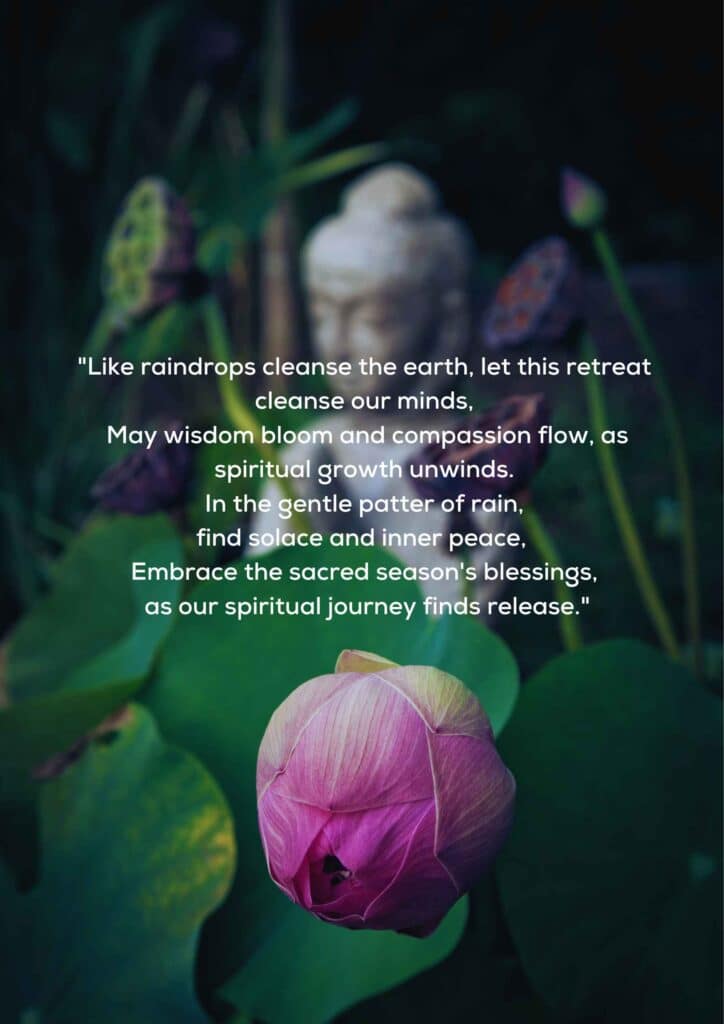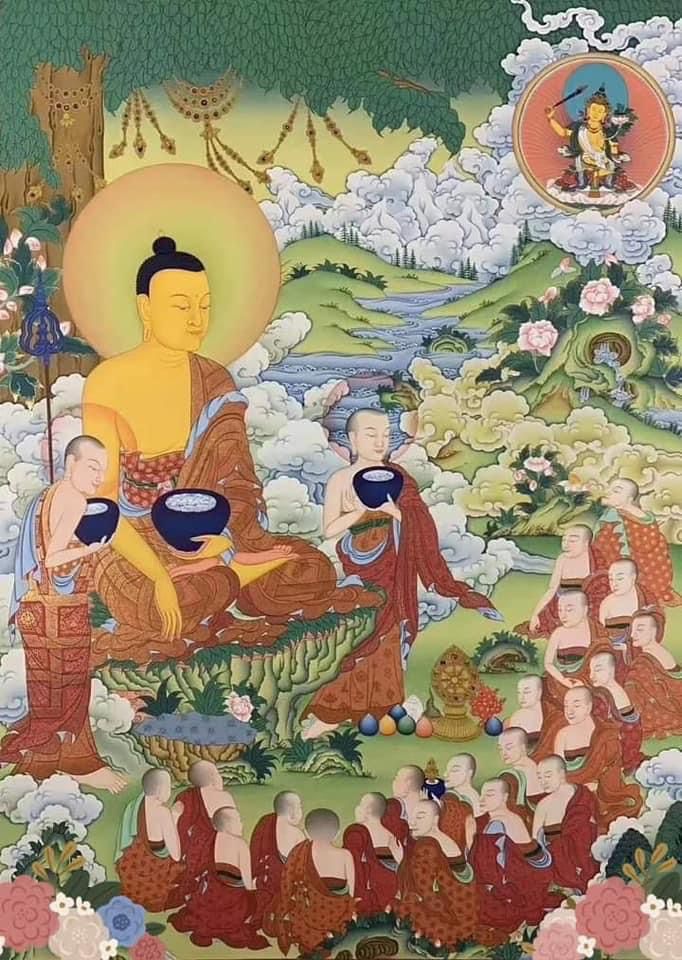
The Historical Evolution of Rain Retreat (Vassavasa)
“In the season of rain, when the rains are falling, many beings come into existence, and many seeds sprout. Realizing this, one should not travel from village to village, but should remain in one place during the rainy season.” — Acaranga Sutra, Jaina Sutras
This passage originates from the practice of Jain mendicants during the era of Buddha in India. It is from this practice that the concept of the rains retreat, or “vassavasa,” emerged within Buddhism.
In the time of Buddha, the Jain mendicants embraced the principle of non-injury (ahimsa) and paused their nomadic ways during the rainy season. Echoing this sentiment, Buddha instructed his disciples to spend the rainy season in established dwellings.
The term “vassavasa” translates to ‘residence during rains,’ commonly referred to as the rains retreat. It is notable that in historical accounts, Buddha delivered his inaugural sermon to five ascetics at Sarnath. During those times, his itinerant preaching was curtailed by the three-month duration of the vassavasa period. Nonetheless, as this practice was not yet a formalized discipline, numerous monks continued to wander intermittently.
There are two significant aspects to consider during this rainy period:
-
Historical Travel Challenges: Traveling during ancient India’s rainy season was arduous due to the adverse weather conditions, contributing to the rationale for stationary residence.
-
Protection of Life: Acknowledging the emergence of numerous living beings and sprouting seeds during the rains, the practice aimed to prevent harm to these forms of life.
The evolution of the rains retreat underscores the transition from nomadism to a period of stillness and reflection, emphasizing the sanctity of life and the interconnectedness of all beings.
Transformation of Routes due to Rain and Monastic Rain Retreats
The pathways became muddied, streets inundated with water, and rivers swelled, effectively impeding the movement of travelers. Moreover, when monks journeyed during the rainy season, they risked causing harm to all living things, including plants and creatures that emerged with the downpours. These actions drew criticism from the populace, prompting the Buddha to establish a guideline. He directed the monks to observe a rains-retreat period at a fixed site.
The specific timeframes of the rains-retreat season exhibited some variability. Throughout this period, the monastic community was advised to settle in locations where provisions like alms and food were conveniently available, without necessitating extensive travel. These sites should be neither excessively distant from villages nor overly proximate, offering ease of access and a balance between solitude and interaction. Ideally, they should be free from daytime congestion, minimize nocturnal disturbances, and maintain a serene ambiance, avoiding both excessive noise and the presence of others.
Within the context of the rains-retreat, Buddhist monastic codes generally outlined two types of dwellings: avasas and aramas in Pali, and viharas in Sanskrit. Avasas were fashioned by the monks themselves, serving as temporary monastic residences defined by natural demarcations such as mountains, rocks, and trees. These were individual spaces that upheld non-interference among monks. Such structures were erected temporarily and subsequently dismantled at the end of the rains-retreat period.
Join us on August 1st as we embark on the sacred and time-honored Rains-Retreat of 2023. This season holds great significance for monasteries worldwide, as they engage in extensive pujas and the reading of sacred texts. It is also a meaningful time for lay practitioners who aim to reduce worldly activities and support the activities of monasteries and monks during this auspicious period.
SEGYU GADEN PHODRANG MONASTERY 2023 RAINY SEASON RETREAT SCHEDULE
August 1st – : Rainy Season Retreat begins with Monastic Confession Ceremony and Guhyasamaja Intensive Sadhana prepatration
August 2nd – 5th Guhyasamaja Intensive Sadhana Session (gsangba ‘duspa’I sgrubmchod) And Fire Puja Offering.
August 6th – 7th: Tara Thread Cross Ceremony (sgrol ma g‐yulmdo sgra grig dang dngos gzhi’I choga rgyas pa)
August 8th – 11th : Heruka Chakrasambara Intensive Sadhana Sessions with Fire Puja Offering (SDROP CHOD)
August 12th -21st : 13 Deity Yamantaka Sand Mandala preparation and construction.
August 14th – 15th : Reading of 105 Volumes of Buddha’s texts (Kangyur)
August 16th – 17th : Simhanada Nagas Rite preparation and actual session (jebtsun-seng gesgra’I kluchog)>>Intensive Naga ritual
August 18th – 20th : Reading of 225 volumes of translated commentaries of Buddha (Tripitaka).
August 22nd – 23rd : 13 Deity Yamantaka Intensive Sadhana Session with Great Consecration Preliminary and Actual day (Rabne Chinmo Tagon dang Ngzhi) Increaing Fire Puja Offering.
August 24th : The International Great Protector Dorje Shugden Celebration. And Yamantaka Consecration conclusion with peaceful Fire Puja Offering.
August 25th – 30th : Increasing pujas (Yangdrup) of White Mahakala (Gonkar), Veshermana (Namsey) and Ratna Shugden (Gayzid)
August 31st : 17th chapter Guhyasamaja Tantra texts reading (dpal gsangba ‘duspa’i rgyudgzhung le’u 17 rgyudphyi ma bcas)
Sept 1st -2nd : Great Kangso preparation.
Sept 3rd -6th : Great Kangso preparation offering to Mahakala, Kalarupa, Sridevi, and Kubera, etc.
September 7th : 550 yrs Death anniversary offerings day of great Master Dhulwa Zenpa Palden Sangpo.
September 9th : Vajra Yogini waxing moon period (Tibetan tenth) offering.
September 10th – 11th : White Umbrella Goddess offering for averting epidemics preparation (gdugs dkar bzlog chen).
September 12th – 13th : White Umbrella Goddess offering for averting epidemics An Actual offering and Torgyag (gdugs dkar bzlog chen)
September 14th : Last day of Rainy Season Retreat. Confession Ceremony and start of monk’s holiday (dga gdbye) for 7 days.
We invite you to create vast amounts of merit by sponsoring food, tea, substances, or new robes. By doing so, you have the opportunity to support and offer dedications through pujas, gathering vast merits for yourself, your loved ones, and all beings in the six realms.

